
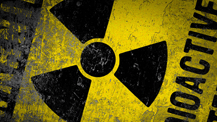
FUKUSHIMA NEWS
~ ~ ~ ~ ~ ~ ~
Help the
NO NUKES Y'ALL
campaign
y'all
Nuclear Watch South is a 501(c)(3) tax-deductible charitable organization.
{ thanks }
PayPal
It's your
safe and secure
way to donate on-line
 |
~ ~ ~ ~ ~ ~ ~
NEW NUKES for Georgia???
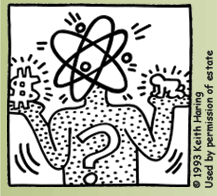
NO THANKS!!!
CLICK HERE

Educating and activating the grassroots to create a
nuclear-free future
~
PO Box 8574
Atlanta, GA 31106
404-378-4263
Cell 404-432-8727
info@nonukesyall.org
NO NUKES Y'ALL!
NUCLEAR WATCH SOUTH | FUKUSHIMA
Oconee Flood Risk:
FUKUSHIMA IN THE FOOTHILLS?
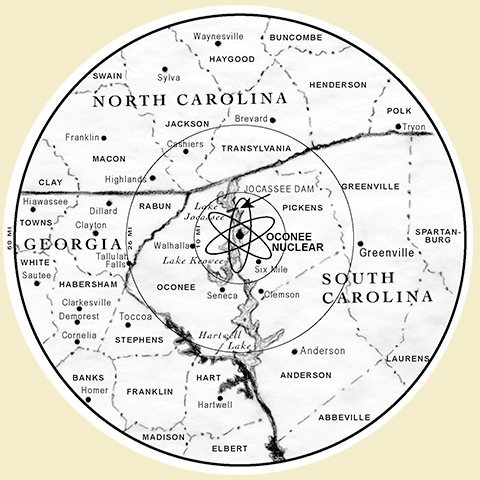
OCONEE NUCLEAR STATION
50-MILE EMERGENCY PLANNING ZONE
3 STATES — 27 COUNTIES — 1,435,128 PEOPLE
TWO SPECIAL EVENTS IN GEORGIA AND SOUTH CAROLINA
WILL OBSERVE FUKUSHIMA 11
Duke Energy’s Oconee nuclear complex is almost 50 years old, as is the Jocassee Dam upstream. Beyond Nuclear’s Linda Pentz and Paul Gunter with Nuclear Regulatory Commission (NRC) whistleblower Jeff Mitman will highlight the risk of meltdowns and radiation releases to the public from neighboring Oconee nuclear reactors if the Jocassee Dam fails, an unacceptably high probability known to both NRC and Duke Energy.
READ THE REPORT
NRC Relicensing Crisis at Oconee Nuclear Station:
Stop Duke from Sending Safety Over the Jocassee Dam
The three aging nuclear reactors threaten not only people and property values but also a region beloved for its beautiful mountains and rivers, forests, lakes, streams, hiking trails, flora and fauna. The risk is great and the stakes are high.
Please join Nuclear Watch South, Beyond Nuclear and Sierra Club to observe the 11th anniversary of Fukushima and to prevent a radioactive tragedy from happening here.
Friday, MARCH 11, 7PM
DINNER AND A MOVIE: A very special evening with Beyond Nuclear
ALONE IN THE ZONE
Four years since the Fukushima Daiichi Nuclear Power Plant went into full meltdown and a 12-mile evacuation zone was enforced,
one cattle farmer still remained, braving high levels of radiation and loneliness to tend to abandoned animals. His name is Naoto Matsumura, the last man standing in the ghost town of Tomioka. VICE Japan documents his views on TEPCO, government inaction, and life in this post-nuclear landscape.
Special guests Linda Pentz and Paul Gunter of Beyond Nuclear join nuclear risk analyst Jeff Mitman to lead an informative discussion about the risk to the public from Oconee nuclear station should the Jocassee Dam upstream fail.
A light supper and live music will be served.
The event is free but RSVP is required by calling 404-378-4263
before March 8, 2022.
Sautee Nacoochee Center, Community Hall
283 Hwy 255 North, Sautee Nacoochee, Georgia 30571
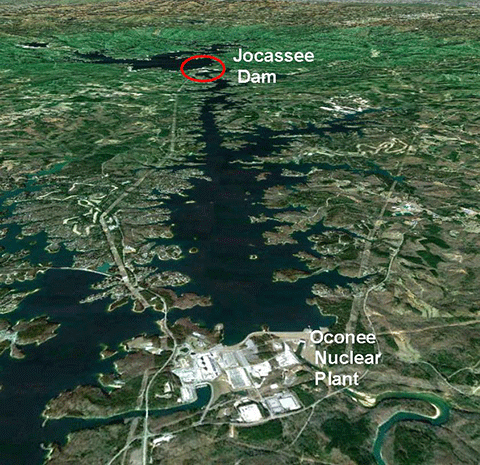
SATURDAY, MARCH 12, 1:30PM
FUKUSHIMA IN THE FOOTHILLS?
Duke Energy is asking the NRC for approval to keep the three Oconee
reactors operating until 2053. Nuclear attorney Diane Curran will join Linda Pentz and Paul Gunter of Beyond Nuclear and NRC whistleblower Jeff Mitman
to discuss the Beyond Nuclear / Sierra Club legal intervention and to present evidence that Duke Energy has failed to ensure the safety of the Oconee nuclear reactors from the possibility of Jocassee Dam failure, flooding of key safety equipment and the real likelihood of core damage and radiation releases
to the public.
The program will be live-streamed.
LINK TO WEBINAR
LINK TO PRESS RELEASE
Osher Center, Clemson University
100 Thomas Green Boulevard, Clemson, SC 29631
EVENTS ARE FREE AND OPEN TO THE PUBLIC
SOCIAL DISTANCING PROTOCOLS WILL BE OBSERVED
CO-HOSTS Beyond Nuclear • Nuclear Watch South • Sierra Club
For more information contact Nuclear Watch South, 404-378-4263
www.nonukesyall.org
FUKUSHIMA EASTER

FUKUSHIMA EASTER, by Glenn Carroll, 2012, mixed media, 7-3/4"x10-1/4"
DARK CIRCLE
7th Annual Fukushima Observance
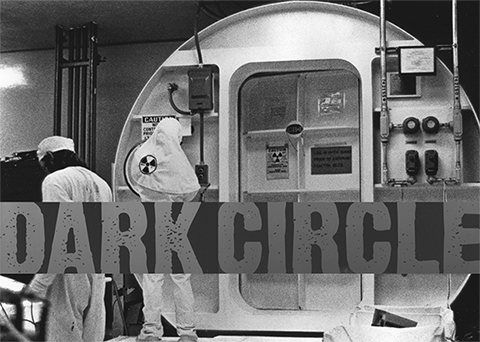
free screening
SATURDAY | MARCH 10, 2018 | 2-5PM
The Meeting Room
Toco Hill-Avis G. Williams Library
1282 McConnell Drive, Decatur 30033
ATLANTA 3/10/18: Please join Nuclear Watch South in observing the 7th anniversary of the triple meltdown at Fukushima Dai-ichi with a special screening of the classic anti-nuclear masterpiece DARK CIRCLE.
This 1982 film by Judy Irving (Wild Parrots of Telegraph Hill) won the grand prize at the 1983 Sundance Film Festival. Subsequently contracted for showing by PBS, the nuclear industry blocked its release calling it “a powerful anti-nuclear piece, which makes the nuclear weapons-power connection more insidiously, more hauntingly, more jarringly than any other film.” After a seven-year lawsuit, PBS founded POV to show strongly pointed films and won an Emmy with its screening of DARK CIRCLE.
DARK CIRCLE has gained potency in its 35-year existence, as it shows starkly the increasingly antiquated views of the nuclear industry in the light of the present day. The film follows plutonium in its global footprints to link nuclear weapons and nuclear power. Issues that the film covers will hit close to home in Georgia where our neighboring Bomb Plant, Savannah River Site, is being short-listed to make plutonium triggers, and the only reactors under construction are behind schedule and over budget in large part because of poor engineering practices by primary contractors at the Vogtle 3 & 4 expansion project.
Please join us for discussion and updates on Fukushima, Savannah River Site and Vogtle following the film screening. Light snacks will be provided and you are welcome to bring your favorite movie foods. Due to the strong subject matter, discretion is advised about bringing young children.
Georgia premiere screening of CONTAINMENT
Nuclear Watch South observes 6th anniversary of Fukushima catastrophe 3/11/17
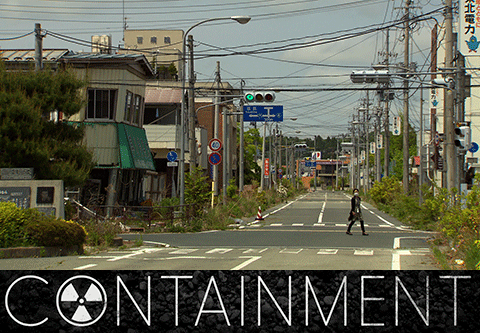
ATLANTA 3/11/17 How can we contain some of the deadliest, most long-lasting substances ever produced? Toxic remnants from the Cold War remain in millions of gallons of highly radioactive sludge, thousands of acres of radioactive land, tens of thousands of unused hot buildings, and some slowly spreading deltas of contaminated groundwater. Governments around the world, desperate to protect future generations, have begun imagining society 10,000 years from now in order to create warning monuments that will speak across time to mark waste repositories.
CONTAINMENT moves from a nuclear weapon facility in South Carolina where toxic swamps have led to radioactive animals, to a deep underground burial site in New Mexico, to Fukushima, Japan, where a triple meltdown occurred after the cooling systems at the Daiichi Nuclear Power Plant were interrupted, leaving that city a ghost town. The film is part graphic novel and part observational essay mixed with sci-fi that is more science than fiction, weaving between an uneasy present and an imaginative, troubled distant future, exploring the struggle to keep waste confined over millennia.
FREE SCREENING
Saturday, March 11, 2017, 2PM
The Meeting Room
Toco Hill-Avis G. Williams Library
1282 McConnell Drive, Decatur, GA 30030
2016 FUKUSHIMA OBSERVANCE in Athens, Georgia
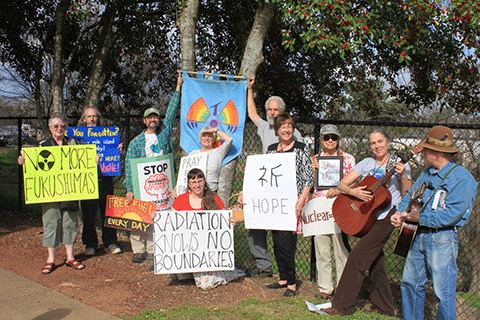
Photo ©2016 Betsy Rivard
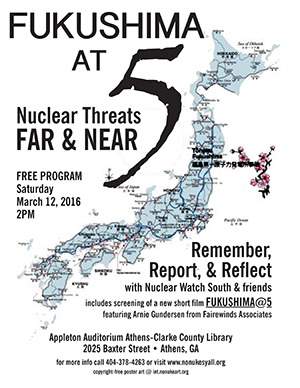 NUCLEAR WATCH SOUTH hosted a free educational program, FUKUSHIMA AT 5, at the Athens-Clarke County Library in Athens, Georgia on March 12, 2016. The event was held in observance of the fifth anniversary of the triple nuclear meltdowns at Japan's Fukushima Dai-ichi following the tragic 2011 Tohoku earthquake and tsunami.
NUCLEAR WATCH SOUTH hosted a free educational program, FUKUSHIMA AT 5, at the Athens-Clarke County Library in Athens, Georgia on March 12, 2016. The event was held in observance of the fifth anniversary of the triple nuclear meltdowns at Japan's Fukushima Dai-ichi following the tragic 2011 Tohoku earthquake and tsunami.
More than 20,000 Japanese people perished in the tsunami following the 9.0 earthquake, and 170,000 people are still displaced in temporary evacuation shelters as Japan copes with the aftermath of its unprecedented nuclear disaster. Thousands of people may never return home again, highlighting the extreme risk of nuclear power.
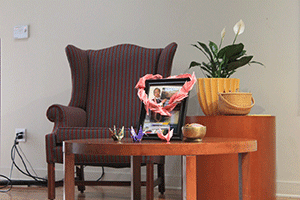 A photograph of Councillor Baba from Namie, in Fukushima prefecture, was placed on the stage in honor of the thousands of Japanese whose lives have been upended by the nuclear accident.
A photograph of Councillor Baba from Namie, in Fukushima prefecture, was placed on the stage in honor of the thousands of Japanese whose lives have been upended by the nuclear accident.
The free program at the Athens-Clarke County Library featured the latest video report from Fairewinds Energy Education nuclear expert ARNIE GUNDERSEN. The video, FUKUSHIMA@5, which is now available on-line, includes information about the reactor flaws that led to the meltdowns in Japan and asserts that U.S. nuclear industry and regulators suffer from the same weaknesses that contributed to Japan's ongoing radiological catastrophe.
Nuclear Watch South board member Richelle Brown presented background information about the GE-designed reactors to give participants a deeper understanding of the technological failure at Fukushima. A lively discussion about nuclear reactors in and near Georgia followed the film, focusing particularly on the triple meltdown threat posed by Duke Energy's Oconee reactors only 60 miles from Athens in the SC foothills. (see following story)
Following the presentations, participants took advantage of the warm Spring weather and reassembled outside for a remembrance ceremony. The strong forces of wind and sunlight uplifted our songs and prayers for a nuclear-free future.
OCONEE: Fukushima on the Savannah River?
Public program highlights Oconee reactors on Fukushima anniversary

CLEMSON, SC 3/11/15: Several local organizations sponsored a talk entitled “Oconee Nuclear: Fukushima on the Savannah River?” at the Unitarian Universalist Fellowship of Clemson at 7PM on March 11, 2015. The main presenters will be Mary Olson of Nuclear Information and Resource Center and Buzz Williams of Chattooga Conservancy. Other organizations sponsoring the talk with Nuclear Watch South were the Foothills Group of the South Carolina Chapter of the Sierra Club and Southern Alliance for Clean Energy.
According to federal regulators, Duke Energy’s Oconee Nuclear Station has three reactors which are at certain risk of a meltdown if the upstream earthen dam at Jocassee were to break. Regulators and Duke Energy have not yet addressed the threat of flooding to the nuclear plant’s safety systems. In addition, this past summer the Nuclear Regulatory Commission further increased its scrutiny of the Oconee Plant after the plant was issued a violation for failure to identify and correct a leaking crack in a weld on a key safety system.
The nuclear information program also coincided with the itinerary of a trio of kayakers who are paddling the entire length of the Savannah River in a project called “Source to Sea ~ Savannah River Pilgrimage 2015.” The project’s mission is “to explore the Savannah River from ‘source to sea,’ connecting people and communities along its 400-mile length; celebrate and document the river's beauty and diversity; and, inspire action to address the threats affecting its health.” The Savannah River was designated the third most polluted river in the U.S. in 2014.
READ THE UNION OF CONCERNED SCIENTISTS REPORT ABOUT OCONEE
Nuclear Watch South visits Atlanta's Japanese Consulate
Remembering victims of 2011 Tohoku tsunami and Fukushima meltdowns
ATLANTA 3/11/15: Nuclear Watch South boardmember Jude Lomas organized a meeting between concerned local citizens and representatives of the Japanese Consulate of Atlanta. The meeting was arranged in recognition of the fourth anniversary of the Tohoku earthquake and tsunami and the subsequent meltdowns at three of the reactors at Fukushima Dai-ichi in Northern Japan.
The action in Atlanta took place in solidarity with similar meetings in every U.S. city hosting a Japanese embassy or consulate. This was the second year for the initiative in which participants ask the Japanese Consul Generals to carry our message of support and concern to Japanese Prime Minister Shinzo Abe.
Deputy Consul General Yasukata Fukahori met with us outside the Japanese consulate's Phipps Tower office near Phipps Plaza and Lenox Square. Tensions in other cities the prior year had reached the ears of Phipps Tower security which apparently insisted that the consulate not allow the citizens group into the building.
Dr. Fukahori met with 8th graders from City of Decatur Renfroe Middle School who gave him a strand of origami cranes and a signed copy of Dr. Arjun Makhijani's landmark study Carbon-Free and Nuclear-Free Future: A Roadmap for U.S. Energy Policy. The City of Decatur has been a nuclear-free zone since 1996.
The letter to Prime Minister Abe was carefully researched with help from Aileen Mioko Smith and Nuclear Information & Resource Service and includes eight demands including medical treatment and relocation assistance, follow-up medical visits with children, food monitoring, repealing the Secrets Protection Act, abandoning plans to restart Japan’s nuclear reactors, stopping the incineration of radioactive rubble and stopping the flow of radioactive water into the Pacific.
The letter concludes: "We write in solidarity with people who have been forced to abandon their homes and hometowns; farmers who have lost their farmlands and their animals; children and mothers who have been poisoned by radiation. Many people will never be able to go back to their homes and businesses because of radioactive contamination. People are afraid their food and water are contaminated and their children are at risk and need good information. We call on the Japanese government to stand with its people through this ongoing tragedy and to resist exploitation and capture by profit-making corporations and the international nuclear industry. Throughout the world, and in the US and in Japan, we must stop creating sacrifice zones, where our people are casualties."
READ THE LETTER TO PRIME MINISTER SHINZO ABE
Standing for the Future: FUKUSHIMA OBSERVANCE
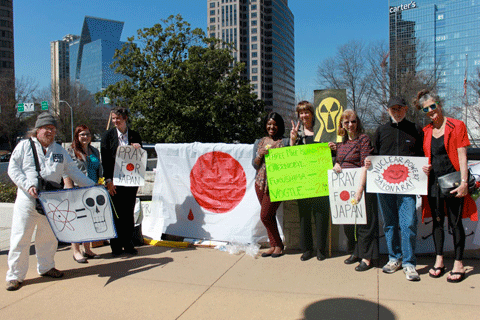
Photo ©2014 Betsy Rivard
ATLANTA 3/11/14 — Activists with Nuclear Watch South and Georgia WAND gathered by the Japanese Consulate in Atlanta to remember the Tohoku earthquake and tsunami that devastated the northern coast of Japan on March 11, 2011, killing nearly 20,000 people and touching off three nuclear meltdowns at Fukushima Dai-ichi nuclear complex. The radiological situation in Japan is still not under control and 135,000 people, by official estimates, are still evacuated from their ancestral homes.
Bearing gifts of flowers and origami peace cranes, we delivered a letter of sympathy and support for the Japanese people addressed to Japanese Prime Minister Shinzo Abe. Deputy Consul General Yasukata Fukahori represented Consul General Kazuo Sunaga to receive the letter for the Atlanta Japanese Consulate.
Dr. Fukahori was frank about the political controversy about restarting Japan's nuclear reactors dividing largely along business and populist lines, and confessed that he does not consider himself an expert on energy issues. He said to the groups' representatives, "I see that you are sincere in your sympathy."
The letter, signed by Nuclear Watch South and Georgia WAND, states in part:
We wish to express our deep sympathy and support for the Japanese people, who are facing the nuclear accident in Fukushima even as they continue to recover from the Great East Japan (Tōhoku) Earthquake and tsunami of three years ago. We wish to affirm the celebrated technological prowess of Japan and her ability meet the challenge of containing and decommissioning the Fukushima Daiichi Nuclear Power Plant, and to lead the world in deploying safe energy systems such as solar, wind and tidal power.
We believe that the primary focus of your government must be on mitigating the catastrophic radiation releases from the Fukushima Daiichi Nuclear Power Plant, preventing further disasters, and developing energy efficiency and safe energy sources instead of on restarting nuclear reactors and exporting nuclear technology. It is important for Japan to conserve its financial, managerial and regulatory resources in order to meet the supreme challenges facing the Japanese people.
CLICK HERE TO READ LETTER TO
JAPANESE PRIME MINISTER SHINZO ABE
PBS NEWSHOUR: Fukushima Crisis Continues to Unfold
DIAL "M" FOR MELTDOWN
Creative collection of devastating nuclear holocaust footage loaded with information.
Video artist RATATAT says: FULL-SCREEN HD recommended: After seeing the destruction in Japan from the Earthquake and Tsunami. Then witnessing Fukushima Nuclear Facility melt down before my very eyes on television. I knew something was not right. My research and investigations were met with dead ends, false readings/answers, and lies. I decided to create this video to make sure the history of Commercial Nuclear power was documented and presented to a younger generation. I found most of the public was turned off by the complex nature of Nuclear Physics, even if what they didn't know was going to kill them and their loved ones.
Meeting Arnold Gundersen and his wife Maggie only opened my eyes to the dangers our country and civilization face because of decisions made decades ago and the lies created to further the nuclear agenda. Their constant truthful testimony against the nuclear industry and their shortcuts and obfuscating, should be a real awakening to the public at large. Creative inspiration came from the GOOD Nuclear Weapons video. Enjoy!
TAKE ACTION>>
FUKUSHIMA | V0GTLE
Day of Remembrance and Warning
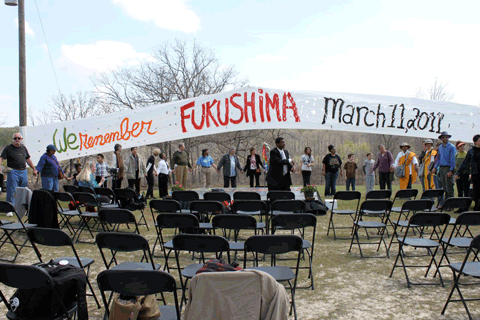
On March 11, 2011 the world's eyes were on Japan as the devastating earthquake and tsunami triggered the Fukushima nuclear disaster, the worst in history.
On March 11, 2012, the world's eyes are also on Georgia where Georgia Power has received a license to build the first two nuclear reactors in the U.S. in 38 years. These reactors would be built at Plant Vogtle in Burke County 40 miles south of Augusta on the Savannah River.
100 people gathered at the Fairfield Missionary Baptist Church in beautiful Burke County to remember the victims of Fukushima and gather strength to stop two new reactors from being added to the two which are already there.
Shoji Kihara from Hiroshima turned down the opportunity to address 10,000 people in Japan in order to be present with us in Georgia. He said that the fate of Vogtle will be powerful influence on the fate of nuclear power.
TAKE ACTION>>
Take a 12-Minute Drive w/Radiation Counters
into the Fukushima
Exclusion Zone
FUKUSHIMA, Japan (4/6/11) This harrowing car trip through the earthquake, tsunami and reactor-ravaged Japanese coast is a must-see to begin to appreciate the magnitude of the radioactive releases and the actuality of the mass exodus of 300,000 Japanese from their homes, possibly forever.
ATOMKRAFT? NEINE DANKE!
GERMANY (3/12/11) The explosion at the Japanese nuclear power plant has given new fuel to a long-running dispute in Germany, where tens of thousands demonstrated on Saturday against plans to extend the life of the country's nuclear power stations. According to the police, some 50 000 people took part in the protest which saw a human chain spread from a nuclear power plant in Neckarwestheim to the city of Stuttgart. Those participating in the demonstration said it was time for the German government to move away from nuclear power. A few weeks later Germany decided to phase out nuclear energy completely.
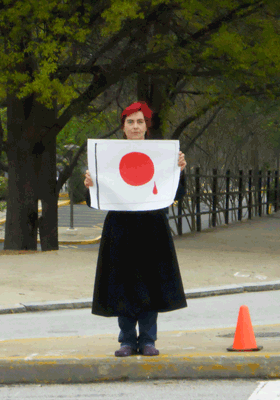 We Remember:
We Remember:
THREE MILE ISLAND
CHERNOBYL
FUKUSHIMA
VOGTLE
ATLANTA (3/28/11) The 32nd anniversary of the nuclear meltdown at THREE MILE ISLAND was observed widely and GREENPEACE helped network more than 200 community vigils.
NUCLEAR WATCH SOUTH and GA WAND took to the streets in Atlanta to remind people that it CAN HAPPEN HERE. As the nuclear holocaust unfolds at
Fukushima we gathered at
rush hour in front of Georgia Power to demand
"NO TAX $$$ FOR VOGTLE!"
TAKE ACTION>>
Nuclear Watch South in nuclear debate on 11 Alive
Longtime NUCLEAR WATCH SOUTH coordinator Glenn Carroll faced off with Georgia Congressional Representative Phil Gingrey on Atlanta's NBC affiliate 11 Alive Saturday morning, March 19, 2011. Popular Atlanta newscaster Karyn Greer moderated the debate about nuclear power and the Japanese nuclear disaster. Gingrey's #11 district in NW Georgia is a little more than 50 miles from TVA's risky ice condenser reactors Sequoyah I & II in Chattanooga, Tennessee.
Plutonium Fuel (MOX) in Fukushima Unit 3,
US Reactors Poses Additional Safety and
Radiation Risks
TOM CLEMENTS, Friends of the Earth SE Nuclear Campaign
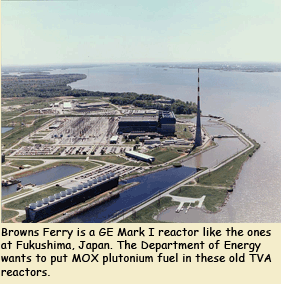 One of the Japanese reactors under risk of continued fuel melting or explosion is now operating for the first time with part of the core being plutonium fuel. This plutonium mixed oxide (MOX) fuel , shipped from Europe and inserted in Fukushima Unit 3 in September 2010, poses greater risks than traditional uranium fuel. MOX, made from plutonium which is capable of being used in nuclear weapons, is harder to control during reactor operation and results in a more serious radiation release in case of an accident, which is the grave threat we are now seeing in Japan. The plutonium in the MOX is a result of the reprocessing of Japanese spent fuel and that program and MOX have long been opposed by public interest groups due to safety, cost and non-proliferation concerns.
One of the Japanese reactors under risk of continued fuel melting or explosion is now operating for the first time with part of the core being plutonium fuel. This plutonium mixed oxide (MOX) fuel , shipped from Europe and inserted in Fukushima Unit 3 in September 2010, poses greater risks than traditional uranium fuel. MOX, made from plutonium which is capable of being used in nuclear weapons, is harder to control during reactor operation and results in a more serious radiation release in case of an accident, which is the grave threat we are now seeing in Japan. The plutonium in the MOX is a result of the reprocessing of Japanese spent fuel and that program and MOX have long been opposed by public interest groups due to safety, cost and non-proliferation concerns.
In the US, the Department of Energy is considering use of MOX fuel in the Tennessee Valley Authority’s (TVA) Browns Ferry reactors, of the same aging Mark I boiling water reactor (BWR) design as Fukushima Unit 3. Analysis by TVA of use of unsafe MOX fuel made from surplus weapons plutonium must be halted and the $850 million request in President Obama’s FY2012 must be rejected. Cost of the MOX plant now under construction at DOE’s Savannah River Site has skyrocketed from $1.4 billion in FY 2004 to $4.9 billion in FY 2009 and has become a program driven by special interests which profit from it.
LINKS
U.S. plutonium disposition program: Uncertainties of the MOX route – March 10
Secret Plan Exposed to Use Surplus Weapons Plutonium in Washington State Nuclear Reactor
Dr. Edwin Lyman ~ Impact of MOX Fuel on Potential for Severe Nuclear Plant Accidents in Japan
TAKE ACTION>>
"To the village square
we must carry the facts
of atomic energy.
From there must come America's voice."
ALBERT EINSTEIN
~~~~~~
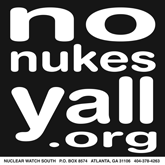
~~~~~~
HOT RESOURCE
~~~~~~
KNOW ABOUT IT
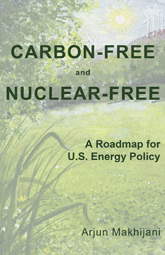
Breakthrough study by IEER proves we can get off coal, oil and nuclear by 2040
FREE DOWNLOAD
READ THE SUMMARY
VISIT THE WEBSITE
~~~~~~
LETTER TO PRIME MINISTER SHINZO ABE
3/11/15
~~~~~~
RESOURCES
DORO-CHIBA
QUAKE REPORT
April 2012
FAIREWINDS.ORG
FUKUSHIMA UPDATES
ENFORMABLE
NUCLEAR NEWS
U.S. NUCLEAR POWER SAFETY ONE YEAR AFTER FUKUSHIMA
Union of Concerned Scientists
FUKUSHIMA TIMELINE
Scientific American
ALL THINGS NUCLEAR
Union of Concerned Scientists
~~~~~~
HOT NEWS!
Worldwatch Institute report finds renewables output surpasses nuclear in 2010
NUCLEAR POWER IN A POST-FUKUSHIMA WORLD
25 Years After the Chernobyl Accident
draft
World Nuclear Industry
Status Report 2010–2011
by
Mycle Schneider,
Antony Froggatt,
Steve Thomas
~~~~~~
WORKERS FLEE JAPAN NUCLEAR PLANT AS SMOKE RISES
boston.com
THE MANHATTAN MELTDOWN SCENARIO
Helen Caldicott
WHAT HAVE THEY DONE TO THE RAIN?
Carl Pope
NUCLEAR NIGHTMARE
Ralph Nader
WORLD MAP OF
NUCLEAR POWER STATIONS
Guardian, U.K.
nukepills.com
NUREG 1150
SEVERE ACCIDENT RISKS:
An Assessment for
Five
U.S. Nuclear
Power Plants
Nuclear Regulatory Commission
NUCLEAR POWER:
A DANGEROUS
WASTE OF TIME
GREENPEACE report
~~~~~~
JAPAN'S
NUCLEAR DISASTER
RESOURCES
JAPANESE ATOMIC INDUSTRY UPDATE SITE
UNION OF CONCERNED SCIENTISTS FACT SHEET
Post-Tsunami Situation at the Fukushima Daiichi Nuclear Power Plant in Japan: Facts, Analysis, and Some Potential Outcomes
Dr. Arjun Makhijani
IEER
NUCLEAR EXPERTS PRESS CONFERENCE
3/13/11
Friends of the Earth
Streaming Audio
MELTDOWNS GROW MORE LIKELY AT THE FUKUSHIMA REACTORS
Robert Alvarez
RISK OF NUCLEAR CATASTROPHE ESCALATES IN JAPAN
Kevin Kamps
HOW A REACTOR
SHUTS DOWN AND WHAT HAPPENS
IN A MELTDOWN
NY Times
Interactive Display
TEPCO
Press Release
3/13/11
HOW BLACK IS THE JAPANESE NUCLEAR SWAN?
Nicole Stoneleigh Foss
JAPAN'S DEADLY GAME OF NUCLEAR ROULETTE
Leuren Moret
NUCLEAR POWER AND EARTHQUAKE ZONES OVERLAP IN THE U.S.
Andrew Schenkel
NUKEPILLS.COM
(U.S. Earthquakes and Reactors Map)
"PUT THE BRAKES" ON NEW NUKE PLANTS
Sen. Joe Lieberman
~~~~~~
JAPANESE ANTI-NUCLEAR GROUPS
CNIC ~ Citizens Nuclear Information Center
GREEN ACTION
~~~~~~



